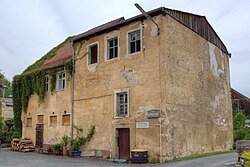Hell 6 (Weismain)
| Hell 6 (Weismain) | |
|---|---|
 The late medieval tanner's house at Hell 6 , next to it at Hell 8 , photo from August 2014 |
|
| Data | |
| place | Weismain, Hell 6 |
| Architectural style | late medieval solid construction with a newer structure |
| Construction year | Late 15th to early 16th centuries |
| Floor space | approx. 65 m² |
| Coordinates | 50 ° 5 '3 " N , 11 ° 14' 16.5" E |
The building hell 6 is a core late medieval former Tanner's House in the Upper Franconian town Weismain . It is the oldest preserved tanner's house in Weismain and has the oldest structure in the city. Under the number D-4-78-176-47 the house is protected as a monument by the Bavarian State Office for Monument Preservation .
history
The building was originally constructed as a tanner's house in the late 15th to early 16th centuries . This was followed by various conversions and extensions to the building, which in the middle of the 20th century also served as a car workshop at times .
Architecture and building function description
The eaves-standing building has an approximately square floor plan and two massive floors. The conclusion is a gable roof from more recent times. On the side of the building facing away from the street, there is the entrance to a vaulted cellar, which the tanners used to temporarily store the fresh pelts at a low temperature. The lime and tan pits required for white and red tanning were located on the ground floor of the house until the 19th century. The tanned skins were dried on poles on the house wall. The building did not have a drying gallery , as is common in most tanneries.
See also
literature
- Peter Ruderich: Weismain's history of art and architecture from the 13th to the 20th century . In: Günter Dippold (Ed.): Weismain , Volume 2, Weismain 1996, ISBN 3-9804106-0-9 , pp. 81-200